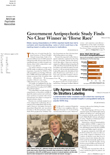Eli Lilly and Co. announced September 29 that it was complying with a request from the U.S. Food and Drug Administration (FDA) to add a“ black-box” warning to the product labeling for atomoxetine (Strattera).
The added language will focus on “uncommon reports of suicidal thoughts among children and adolescents” taking the drug. In conjunction with the action, the FDA issued a Public Health Advisory and updated its online “Healthcare Professional Information Sheet” for the drug.
Atomoxetine, a selective norepinephrine reuptake inhibitor (SNRI), is approved in the United States for treatment of attention-deficit/hyperactivity disorder (ADHD) in adults and children aged 6 and older.
In separate statements, both Lilly and the FDA said that the action was taken as a result of the company's submission of an “analysis of adverse-event data from its Strattera clinical-trials database that identified a small but statistically significant increased risk of suicidal thoughts among Strattera-treated children and adolescents” compared with patients in those trials taking placebo.
The FDA also requested that Lilly develop a medication guide for patients and caregivers.
The FDA has no statutory authority to require specific labeling or medication guides. Rather, it is limited to requesting action from a drug manufacturer and normally must negotiate final labeling language with the company. If a drug maker does not agree with the agency's request, the FDA has the option to declare the product under discussion “misbranded” and begin legal proceedings that could result in the product's removal from the market. That process is cumbersome, however, and has rarely been used.
The director of the FDA Center for Drug Evaluation and Research, Steven Galson, M.D., characterized the action as “another example of the agency acting swiftly to alert the public to significant drug safety information needed to use a drug in a safe manner.” Yet, in this instance, the option of adding a black-box warning to the atomoxetine label was suggested by Lilly itself when it submitted data from 12 clinical trials involving approximately 2,200 children and adolescents.
The data were requested by the FDA (and other regulators around the globe) as part of an ongoing review of safety data relating to psychiatric medications. Specifically, the agency asked Lilly for data on “possibly suicide-related” adverse events occurring in any of the placebo-controlled trials of atomoxetine. Suicide-related adverse events include both suicidal thoughts and behaviors.
Lilly submitted the dataset to the FDA and other regulators on September 15. The company also submitted two analyses of the adverse-event data. Data from 12 pediatric trials were submitted (eight involving patients who had only ADHD, the others involving patients with ADHD and comorbidities such as major depression or anxiety). Nine trials of the drug in adults were submitted, three concerning ADHD and six involving major depression.
Of the 2,200 children and adolescents studied, 1,357 received the drug, and 851 received placebo. Five “possibly suicide-related” cases were identified in patients taking atomoxetine (0.37 percent), and no cases appeared in those taking placebo. A sixth case was identified and classified as a suicide attempt in a patient taking the drug. All of the cases represent spontaneously reported adverse events. None of the clinical trials' protocols appear to have used standardized measurements of suicidal thinking or behavior.
According to the Centers for Disease Control and Prevention, 17 percent of adolescents think about suicide a year. Among high school students, 12 percent of girls and 5 percent of boys attempt suicide a year. Ultimately, 2 per 100,000 girls and 12 per 100,000 boys die as a result of such attempts. In the United States, this translates into approximately 2,000 young people who die as a result of suicide.
Overall, pediatric patients taking atomoxetine were deemed to be about 2.5 times more likely to have a “possibly suicide-related” event than those who took placebo. A Lilly meta-analysis of suicide-related behaviors in the placebo-controlled atomoxetine studies showed that of six events, five involved suicidal ideation, while only one involved actual suicidal behavior. Of these events, all occurred in males under age 12. There were no completed suicides.
The Lilly analysis further noted that the “number needed to harm” for suicidal ideation was 271 for all pediatric patients in the clinical trials. That is, 271 patients would have to be given atomoxetine before one patient would experience a “possibly suicide-related” event. In contrast, only four patients would need to receive medication to have one pediatric patient experience a remission (defined as greater than or equal to a 40 percent reduction in the ADHD Rating Scale total score).
Analysis of the nine adult trials showed no increased risk of“ possibly suicide-related” events.
Other regulatory agencies announced similar updates to approved product labeling in their jurisdictions, including Canada, the European Union, and Australia. In Canada, the warning will appear similar to that in the United States, as a boxed, bolded warning in the product labeling. In most countries of the European Union, the information will appear under the “Special Warnings” section of the label. However, the United Kingdom's Medicines and Healthcare Products Regulatory Agency said it is “looking into the health risks and benefits of [atomoxetine],” and new labeling may be announced soon. In Australia, the new warning will appear as a“ Precaution.”
The FDA's MedWatch notification on Strattera is posted at<www.gda.gov/medwatch/safety/2005/safety05.htm>. Links to the agency's Public Health Advisory and Healthcare Professional Information Sheet are posted there as well. ▪
